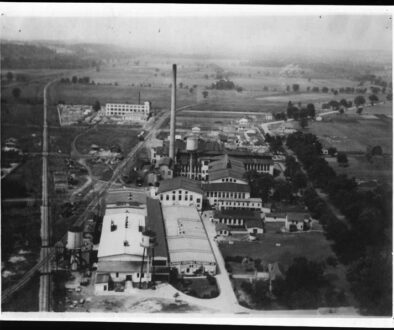Monsanto’s former CEO testifies in Roundup trial, points to EPA safety findings
Former Monsanto chief Hugh Grant spent several hours on the witness stand on Tuesday – testifying for the first time in front of a jury at a Roundup trial – telling the court repeatedly that global regulators had found no evidence that the company’s herbicides cause cancer.
Under sharp questioning from the plaintiff’s attorney in the case, Grant answered questions about whether or not Monsanto had a duty to warn consumers of a cancer risk by saying there was no such established risk.
“The product had been examined and studied almost continuously for 40 years around the world and had never been deemed to be a carcinogen,” he said. “It’s a circumstance that never occurred. There was never, never a need to communicate such a hypothetical.”
During his 37 years at the company, Grant said: “The reality is that based on regulatory examination almost constantly during that entire period the product was never found to cause cancer.”
In multiple answers to a range of questions regarding the company’s messaging to consumers, Grant cited the U.S. Environmental Protection Agency (EPA) as the authority for determining what information is displayed on product labels.
“The label isn’t designed by Monsanto,” he said.
Grant, 64, was called as a witness in the case of Allan Shelton, a 34-year-old man suffering from non-Hodgkin lymphoma (NHL) who alleges his repeated use of Monsanto’s Roundup herbicides caused his disease.
Lawyers for Monsanto sought to block Grant from having to appear live at the trial, which is taking place in Jackson County Circuit Court in Kansas City, Missouri. But the judge in the case and an appeals court denied the company’s request.
Multiple sources involved in the case said settlement talks over the weekend nearly netted a deal, but ultimately fell short and the trial resumed Tuesday.
Shelton, who lives in Kansas City, Mo., was diagnosed with NHL in May 2016, a little more than a year after international cancer scientists affiliated with the World Health Organization classified the active ingredient in Roundup, a chemical called glyphosate, as a probable human carcinogen.
Shelton’s lawsuit against Monsanto mirrors tens of thousands of other U.S. lawsuits filed since the 2015 classification by the International Agency for Research on Cancer (IARC). His lawyers allege Monsanto knew of scientific research showing its product could cause cancer, but failed to warn consumers, instead working to suppress and manipulate information about Roundup dangers.
Jousting match
Grant left Monsanto in June of 2018 when the St. Louis-based seed and chemical powerhouse was acquired by Germany’s Bayer AG for $63 billion.
In answering questions from Shelton attorney Roe Frazer on Tuesday, Grant said after liquidating all of his accumulated shares he left Monsanto with roughly $75 million.
Monsanto lawyers raised numerous objections to both the tone and content of Frazer’s questioning of Grant, successfully deflecting multiple lines of questioning.
In one exchange, Frazer asked Grant if he knew what “a consumer” was; to which Grant confirmed that indeed he did.
In another, Frazer asked Grant about language he said was part of Occupational Health and Safety Administration warnings regarding protective clothing for Roundup, and Grant in turn asked Frazer multiple times to show him a document with such language. Frazer did not comply and moved to a different line of questioning.
At one point Frazer used the questioning of Grant to show jurors a September 2015 communication to Monsanto from the American Academy of Pediatrics telling the company the group was returning more than $500,000 to Monsanto, saying it could not continue to “partner” with Monsanto due to concerns about glyphosate impacts on health.
“Humble” upbringing
Under questioning from Monsanto attorney Hildy Sastre, Grant described for jurors what he said was a “humble” background, growing up in a small town in west Scotland in a one-bedroom home with no indoor bathroom. His two grandfathers both worked in area coal mines and neither of his parents graduated high school, Grant recounted.
He became the first in his family to graduate from high school and to attend and graduate from college, obtaining a degree in molecular biology, he testified. He married his childhood sweetheart, to whom he is still married, and focused his graduate studies and then his career on agriculture, working for a time on a dairy farm and later a potato farm, Grant testified.
He joined Monsanto in July 1981, spending his entire professional career at the company. Grant said he still lives in St. Louis, Missouri, where Monsanto was headquartered until the acquisition by Bayer.
In answer to a question about his feelings about his successful career and wealth, Grant said he considered himself a “lucky individual.”
“I am very grateful, and I count my blessings every day,” he said. “I’m very proud of the work I did, but I’m much prouder of the team that I built and people that I worked with.”
In addition testimony under questioning from Sastre, Grant denied that the company had a “plan” or “agreement” with the EPA to support the safety of Roundup. And he told jurors that glyphosate-based weed killers were very beneficial to farmers, helping them avoid tilling the ground, a practice that has an array of negative environmental impacts.
At one point during questioning about Monsanto’s stable of genetically engineered crops, Grant spoke almost wistfully about the company’s abandonment of a plan to introduce a “Roundup Ready” genetically engineered wheat that would not die if sprayed with glyphosate herbicides. In the late 1990s and 2000s Monsanto introduced an array of such glyphosate-tolerant crops, including Roundup Ready soy and corn, cotton and canola.
But the company dropped plans for Roundup Ready wheat in May 2004 amid an uproar from global wheat buyers who threatened to stop buying wheat supplies from the United States if a genetically engineered wheat was introduced.
In Tuesday’s testimony Grant said it was unfortunate there was no Roundup Ready wheat today given the feared shortages due to the war in Ukraine.
As questioning wound down, Frazer asked Grant if anyone had ever gotten non-Hodgkin lymphoma from “pulling weeds.”
Sastre concluded her questioning of Grant by asking if he knew if people got non-Hodgkin lymphoma before glyphosate herbicides were introduced in 1974.
Monsanto has long insisted that there is no valid evidence of a cancer connection between its weed killing products and cancer. Still, Monsanto lost the first three cases to go to trial as juries awarded over $2.3 billion in damages to four plaintiffs. The damages were later lowered but the jury findings in favor of plaintiffs were upheld on appeals. Juries in the most recent two cases to go to trial found in favor of Monsanto.
Bayer has announced that it will stop selling Roundup, and other herbicides made with glyphosate, to U.S. consumers by 2023, but said the move is solely to “manage litigation risk and not because of any safety concerns.” The company plans to continue to sell its glyphosate-based herbicides for commercial use and for use by farmers.
Bayer has set aside more than $11 billion for Roundup litigation settlements, but while the majority of plaintiffs in the nationwide Roundup litigation have settled, many more are pushing for trials.
A trial is planned for July in St. Louis, and two cases are set for trial in St. Louis early next year.
 EWG
EWG



June 2, 2022 @ 11:08 pm
It’s unfortunate that the plaintiff attorney couldn’t produce an SDS (Safety Data Sheet) pertaining to the Personal Protective Equipment (PPE) the attorney had referenced. The SDS is mandated by OSHA. At one point, the SDS also contained language pertaining to IARC’s 2A -Probable Carcinogen classification.
Global regulatory agencies did NOT study the “product” – that’s bullshit – they reviewed glyphosate only, which is only part of the product. FIFRA clearly defines the difference between a ‘pesticide’ (Roundup) and an ‘active ingredient’ and it’s misbranding provisions and labeling requirements pertain ‘pesticide(s)’ not active ingredient(s)’.
So, again, it’s false to state that regulators studied the product, the product is Roundup formulations, which are indisputably more toxic to all living organisms, including humans, than glyphosate. Monsanto intentionally didn’t study the “product[s’]” adverse effects; however, the company was well aware of its toxicity.
The EPA and it’s labeling requirements are also based off of Monsanto’s acute toxicity data they provided to EPA. The chronic adverse effects of Roundup were buried- Dr. Parry’s genotoxicity conclusions were never submitted to the EPA, which also violates FIFRA and EPA requirements.
Was he asked about knowledge of ghostwriting? Particularly, that occurred in William’s 2000? What’s his response to Monsanto ghostwriting to circumvent regulatory agencies from opening doors they didn’t want to open? What about the company spending $16M to counter IARC – the “Orchestrate Outcry” initiative – in 2016 alone vs performing studies on the acute, sub-chronic, and chronic toxicity of Roundup formulations (ie “the product”).
$75M, huh? That’s incredible. What was the desperation and urgency of Monsanto to acquire or merge with Syngenta in late 2014 & 2015 about? Looking for a new chemical because Monsanto only had glyphosate and knew it was up for an IARC review? Why was the company “fearing” an IARC review if it was so studied and so safe?
Don’t believe a word this guy says…they were planning Roundup Ready crops before they had carcinogenicity data on glyphosate – just read ‘Lords of the Harvest’. Their vision to ‘Feed the World’ was in affect and they had thrown all the eggs in one basket, we’ll before EPA classified glyphosate as ‘possibly carcinogenic’ in 1985.
Hope the attorneys know their stuff….
June 2, 2022 @ 11:03 pm
It’s unfortunate that the plaintiff attorney couldn’t produce an SDS (Safety Data Sheet) pertaining to the Personal Protective Equipment (PPE) the attorney had referenced. The SDS is mandated by OSHA. At one point, the SDS also contained language pertaining to IARC’s 2A -Probable Carcinogen classification.
Global regulatory agencies did NOT study the “product” – that’s bullshit – they reviewed glyphosate only, which is only part of the product. FIFRA clearly defines the difference between a ‘pesticide’ (Roundup) and an ‘active ingredient’ and it’s misbranding provisions and labeling requirements pertain ‘pesticide(s)’ not active ingredient(s)’.
So, again, it’s false to state that regulators studied the product, the product is Roundup formulations, which are indisputably more toxic to all living organisms, including humans, than glyphosate. Monsanto intentionally didn’t study the “product[s’]” adverse effects; however, the company was well aware of its toxicity.
The EPA and it’s labeling requirements are also based off of Monsanto’s acute toxicity data they provided to EPA. The chronic adverse effects of Roundup were buried- Dr. Parry’s genotoxicity conclusions were never submitted to the EPA, which also violates FIFRA and EPA requirements.
Was he asked about knowledge of ghostwriting? Particularly, that occurred in William’s 2000? What’s his response to Monsanto ghostwriting to circumvent regulatory agencies from opening doors they didn’t want to open? What about the company spending $16M to counter IARC – the “Orchestrate Outcry” initiative – in 2016 alone vs performing studies on the acute, sub-chronic, and chronic toxicity of Roundup formulations (ie “the product”).
$75M, huh? That’s incredible. What was the desperation and urgency of Monsanto to acquire or merge with Syngenta in late 2014 & 2015 about? Looking for a new chemical because Monsanto only had glyphosate and knew it was up for an IARC review? Why was the company “fearing” an IARC review if it was so studied and so safe?
Don’t believe a word this guy says…they were planning Roundup Ready crops before they had carcinogenicity data on glyphosate – just read ‘Lords of the Harvest’. Their vision to ‘Feed the World’ was in affect and they had thrown all the eggs in one basket, we’ll before EPA classified glyphosate as ‘possibly carcinogenic’ in 1985.
Hope the attorneys know their stuff….
June 1, 2022 @ 7:00 pm
Dec 27, 2016 WHO Agency Declared Roundup Weed Killer As Cancer Causing
Monsanto’s Roundup has been linked to a myriad of health issues ranging from cancers to neurological defects to infertility. Still, we’re pouring 100 million tons of this toxin into the environment every year. America’s Lawyer Mike Papantonio and Farron Cousins discuss the dangers that Monsanto is hiding from the public.
https://youtu.be/AM9BjL3SkrE
May 31, 2022 @ 10:39 pm
But is there evidence?
Would be interesting if someone asked why they are settling lawsuits. (That’s kind of like evidence)
May 31, 2022 @ 10:38 pm
But is there evidence…. Why are they settling lawsuits?